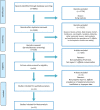Prevalence of Clostridioides difficile contamination in the healthcare environment and instruments: A systematic review and meta-analysis
- PMID: 37680683
- PMCID: PMC10482474
- DOI: 10.18683/germs.2022.1340
Prevalence of Clostridioides difficile contamination in the healthcare environment and instruments: A systematic review and meta-analysis
Abstract
Introduction: Worldwide, Clostridioides difficile infection is becoming one of the most common healthcare-associated infections. Management and control of this infection in healthcare facilities are associated with screening for environmental and instrumental C. difficile contamination. This systematic review and meta-analysis aimed to assess the overall prevalence of C. difficile in hospital settings, medical devices, and instruments.
Methods: Four main databases, PubMed, Web of Science, Google Scholar, and Scopus, were searched using the keywords Clostridioides difficile, Clostridium difficile, C. difficile, clostridia, Clostridium spp., hospital environments, antibiotic associate colitis, intensive care unit, and ward in combination as a search strategy. The PRISMA checklist was used for selecting eligible studies.
Results: A total of 11 eligible articles published between 2012 and 2021 were included. The overall pooled prevalence of C. difficile in hospital environments was 14.9%. The highest and lowest prevalence were reported for India (51.1%) and the USA (1.6%), respectively. The highest prevalence was reported for beds (46.3%). A significant heterogeneity was seen between C. difficile prevalence in hospital environments in different samples. The highest and lowest prevalence was reported for floor corners (63.2%) and privacy curtains (1.4%), respectively.
Conclusions: In conclusion, hospitals' medical devices and environmental surfaces are considered a crucial source of Clostridioides difficile infection. In this regard, we strongly recommend revising and improving the cleaning and disinfection methods in hospitals and quality control of cleaning adequacy.
Keywords: Clostridioides difficile; healthcare environment; meta-analysis; prevalence.
GERMS.
Conflict of interest statement
Conflicts of interest: All authors – none to declare.
Figures
References
LinkOut - more resources
Full Text Sources
Miscellaneous


